News
Movie Embroidery: Reimagining 10 Iconic Film Moments in Thread
In a world where digital art and cinema rule our screens, there’s something deeply poetic and enduring about interpreting stories through the texture of thread.
Embroidery—a centuries-old craft—has seen a remarkable revival, not only in fashion and home decor but as a medium for modern visual storytelling.
And when it meets pop culture, especially cinema, magic happens.
In this post, we’ll dive into 10 of the most iconic movie scenes that have been lovingly, and often painstakingly, reimagined through embroidery.
Each embroidered scene is more than just fan art—it’s a tactile tribute, a celebration of texture and detail that digital cannot replicate.
Whether you’re a film buff, embroidery artist, or just curious about this unique art form, prepare to be inspired by the fusion of stitch and cinema.
Titanic (1997) – The Ship of Dreams
The RMS Titanic, dubbed the “Ship of Dreams,” sails across the Atlantic in majestic glory.
From its first reveal in the film to its ill-fated descent into the ocean, the ship itself is a character—symbolizing both human ambition and fragility.
Embroidery artists have reimagined the Titanic in breathtaking detail.
From its towering smokestacks and rows of glowing windows to the still waters it cuts through, the ship is brought to life through layered stitching, metallic threads, and dramatic sky backdrops.
Some designs focus on the ship at dusk, with fiery sunsets reflected in the water, while others capture the haunting silhouette of the sinking ship under moonlight.
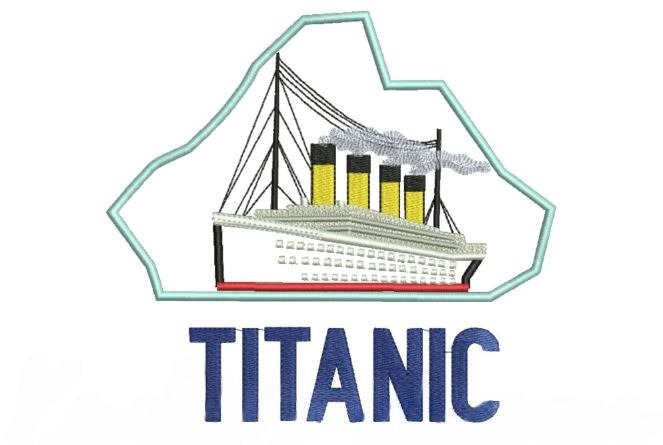
The Lion King (1994) – “Simba on Pride Rock”
As “Circle of Life” crescendos, baby Simba is held high over the savanna from Pride Rock. It’s a powerful symbol of legacy and the natural order.
This scene lends itself to highly stylized embroidery, often incorporating African patterns and rich earth tones.
Some artists even reimagine it in abstract or geometric stitch forms, giving it a regal, timeless quality.
Embroidery Elements:
- Layered felt for dimensional animals
- French knots for grassland textures
- Radiant sun rays with gold or variegated thread
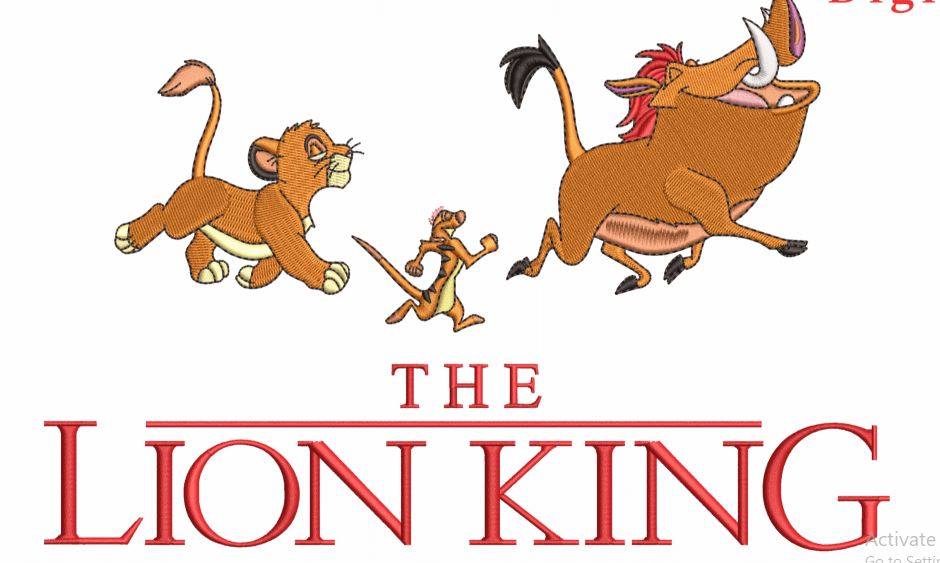
Pulp Fiction (1994) – The Dance Scene
Vincent Vega and Mia Wallace on the dance floor of Jack Rabbit Slim’s—awkward, cool, and unforgettable.
The contrast-heavy nature of this scene—black suits, white shirts, red lips—makes it a playground for high-contrast embroidery.
Many embroidered versions simplify the background, focusing solely on body language and expressions, with minimalist thread lines capturing the groove.
Popular Techniques:
- Split stitch outlines
- Chain stitch for dynamic motion
- Hand-beaded lights in the background
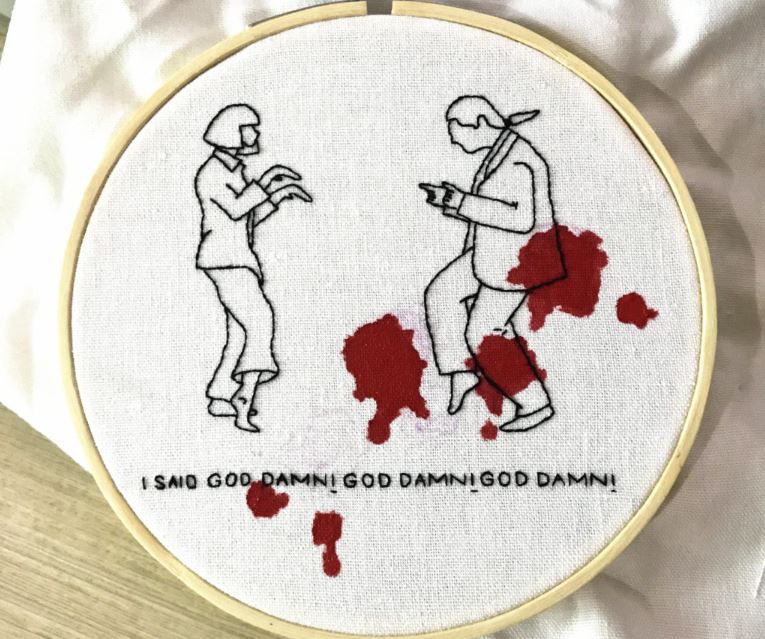
The Matrix (1999) – “Bullet Dodge”
Neo bends backward in slow motion, dodging bullets as the world distorts around him—a defining visual in sci-fi.
Fiber artists have cleverly used layers of green-toned thread, mirroring the digital rain motif of the Matrix.
Neo’s silhouette is often embroidered in dark fabric with three-dimensional thread effects mimicking bullet trails and ripples.
Creative Touches:
- Glow-in-the-dark thread for bullets
- Motion blur simulated with ombré thread gradients
- Matrix code stitched in the background
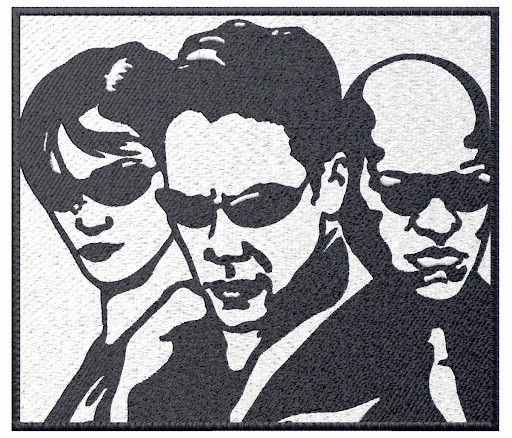
Breakfast at Tiffany’s (1961) – Holly Golightly’s Window Scene
Audrey Hepburn in her iconic black dress and pearls, coffee and croissant in hand, gazes into Tiffany’s storefront window.
Artists reimagine this in delicate, monochrome palettes or even in pastel to reflect Holly’s dreaminess.
Tiny threadwork details capture the elegance of her updo, her long lashes, and the glint of window reflections.
Stitch Focus:
- Satin stitch for her sunglasses
- Silk thread for her dress’s sheen
- Beads for Tiffany diamonds in the window
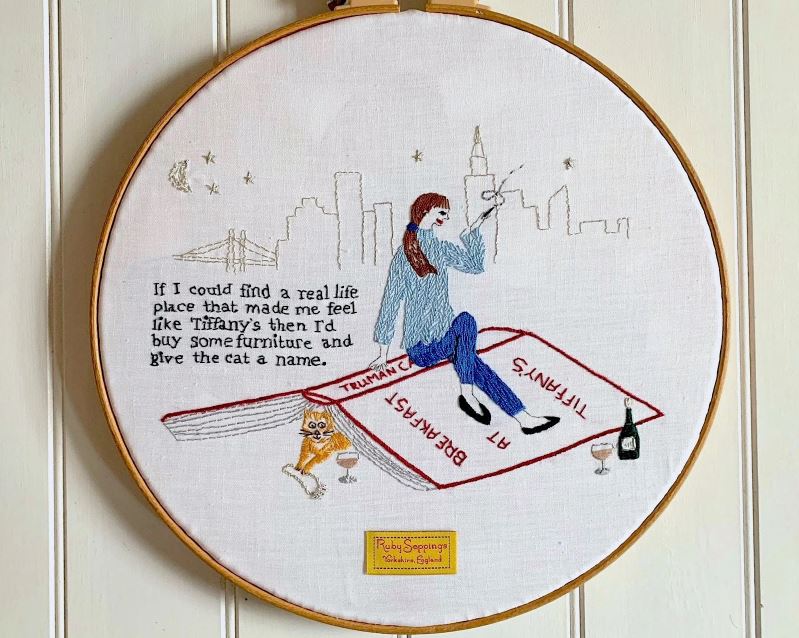
Star Wars: A New Hope (1977) – Twin Suns of Tatooine
Luke Skywalker looks into the horizon as twin suns set over the sands of Tatooine—quietly longing for adventure.
With its warm palette and stark landscape, this moment becomes a minimalist masterpiece in embroidery.
Artists often emphasize color gradients in the sky, and some even incorporate glow effects using metallic or silk threads.
Techniques Used:
- Long and short stitch for sunsets
- Layered fabric appliqué for sand dunes
- Negative space to highlight solitude
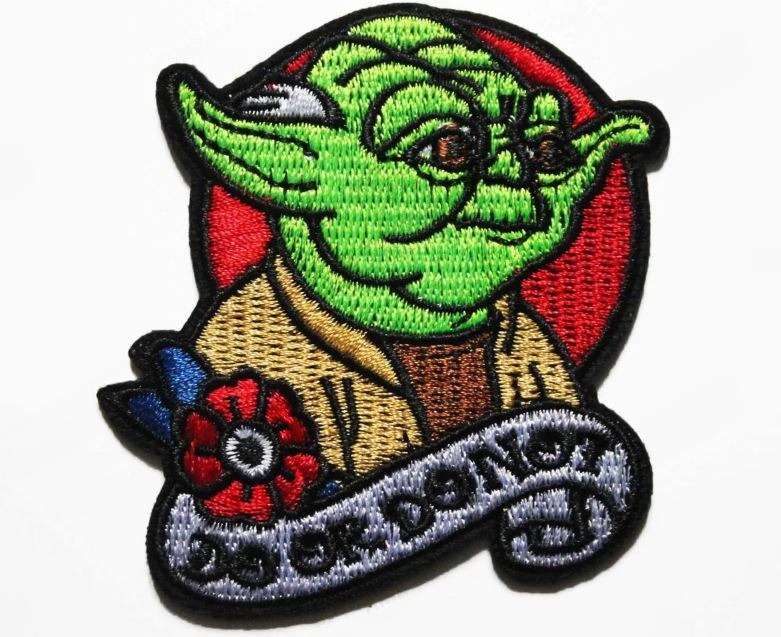
The Shining (1980) – “Here’s Johnny!”
Jack Nicholson’s face bursts through a broken door—wild eyes, crazed grin—shouting the famous line.
This intense moment has found its way into embroidery as both horror tribute and kitsch art.
Often stylized in comic-book or pop-art embroidery styles, it’s a playground for exaggeration.
Standout Features:
- Bold split stitches for facial lines
- Appliqué for splintered door effects
- Red thread typography for the infamous line
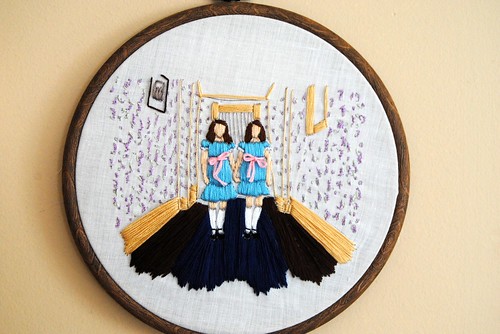
Forrest Gump (1994) – “Run, Forrest, Run!”
Forrest sprints down the road with braces breaking off his legs—freedom in motion.
This embroidered scene is often illustrated with elongated running forms and sweeping stitch lines that convey speed.
Many artists include the dusty road trailing behind Forrest using rougher thread textures like wool or jute.
Motion Techniques:
- Couching technique for broken braces
- Repeated outlines to show motion blur
- Directional fill stitches mimicking wind and speed
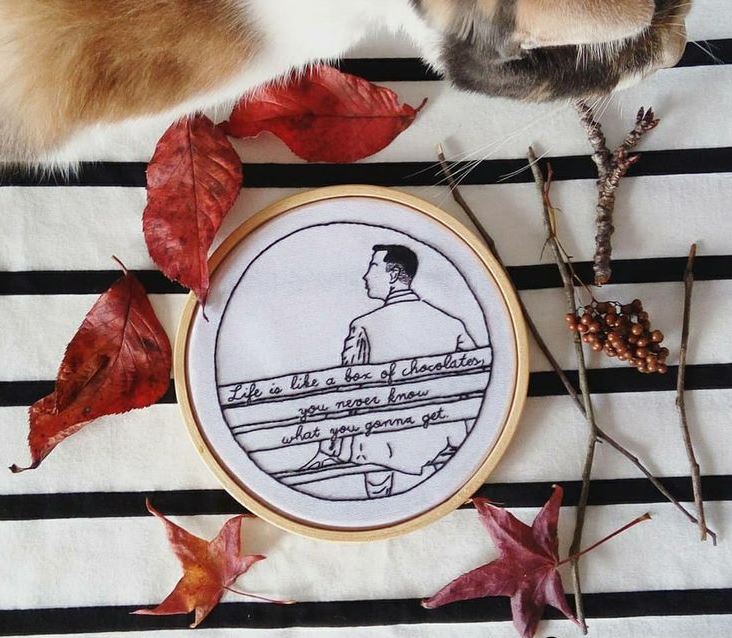
Jurassic Park (1993) – T-Rex Breakout
The moment the T-Rex breaks through the electric fence in the rain, roaring under lightning flashes.
Artists revel in the challenge of depicting this scene with layers of textured thread for rain, mud, and scales.
Some embroiderers have even added interactive elements like glow-in-the-dark eyes or metallic floss for the fence sparks.
Fiber Techniques:
- 3D embroidery for the T-Rex’s head
- Wet-look simulated with satin thread
- Felt and fabric collage for the jungle backdrop
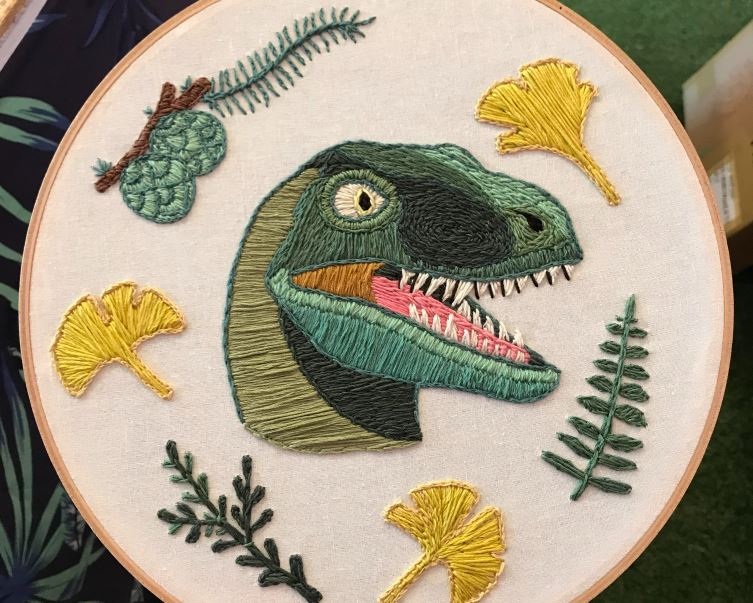
La La Land (2016) – Griffith Park Dance
Mia and Sebastian dance silhouetted against the twilight skyline of Los Angeles—dreamy, whimsical, romantic.
This embroidered scene often comes in silhouette form, with their figures stitched in dark thread while the background plays with color gradients of a dusk-lit city.
Hand-dyed fabrics are sometimes used as backgrounds to add natural color blends.
Romantic Details:
- French knots for city lights
- Hand-painting combined with embroidery
- Silk threads for dress movement
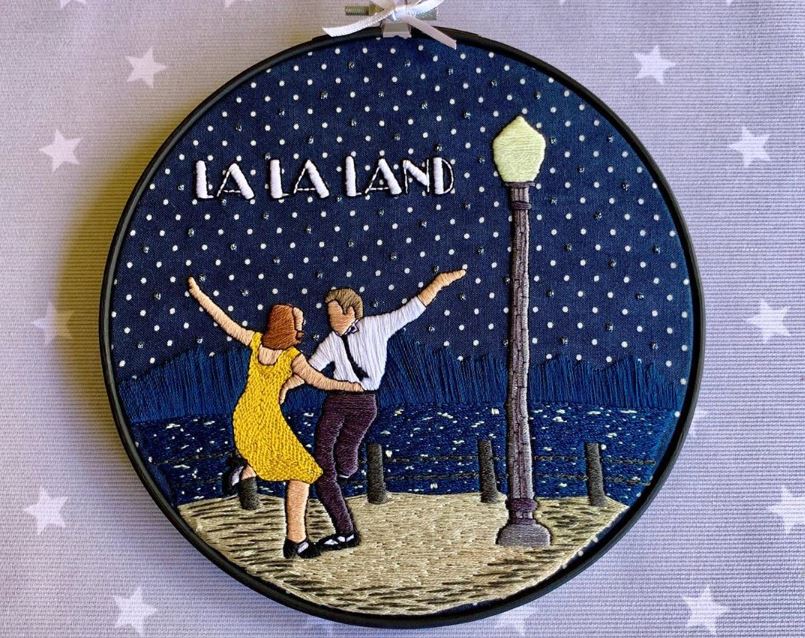
The Emotional Weight of Thread
What makes these embroidered scene so captivating is that they distill cinematic spectacle into handmade stills.
In each stitch is time, patience, emotion—a far cry from the instant gratification of digital fan art.
Artists aren’t just copying scenes—they’re reinterpreting them, making them personal, tactile, and intimate.
Some even push the boundaries further by:
- Mixing textiles and digital embroidery for hybrid works
- Using AR filters to animate their stitched scenes
- Designing wearable embroidered fan art (shirts, patches, bags) featuring these iconic frames
Final Thread: The Cinematic Power of Handmade Art
Each of these embroidered interpretations reminds us that movies aren’t just entertainment—they’re emotional landmarks.
And movie embroidery is more than needle and thread—it’s storytelling in stitches. When the two collide, the result is visual poetry.
So whether you’re an embroidery artist looking for your next muse or a film lover seeking fresh expressions of beloved classics, dive into this growing world where movies are immortalized not just on screens, but in fabric, thread, and heart.

